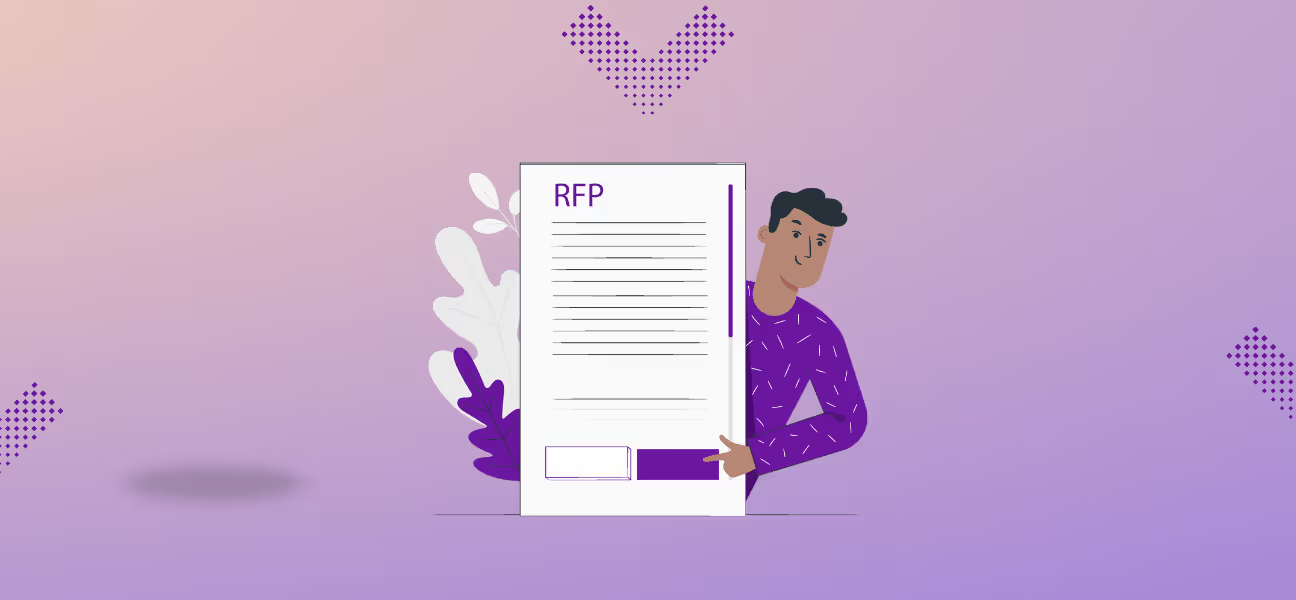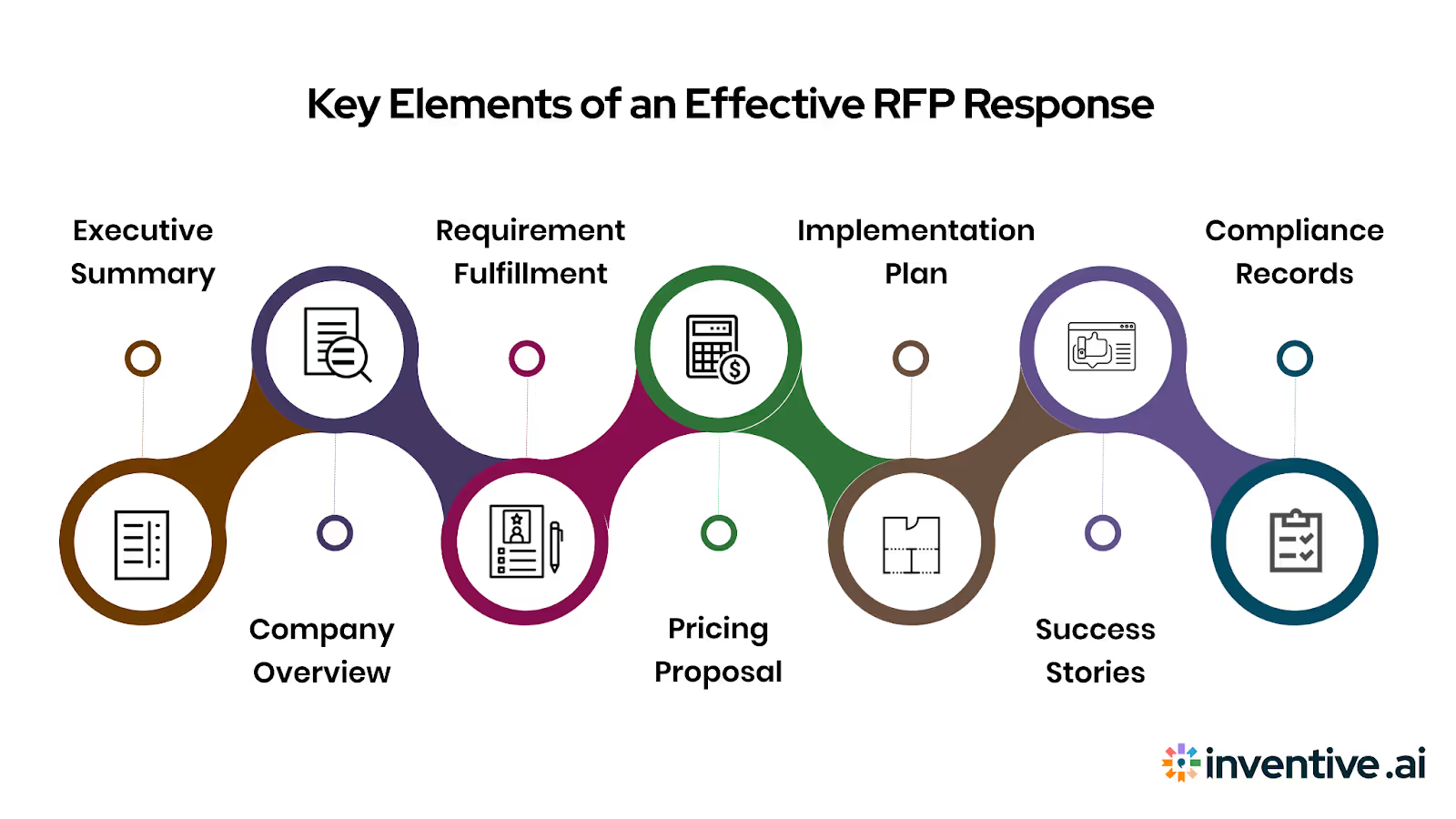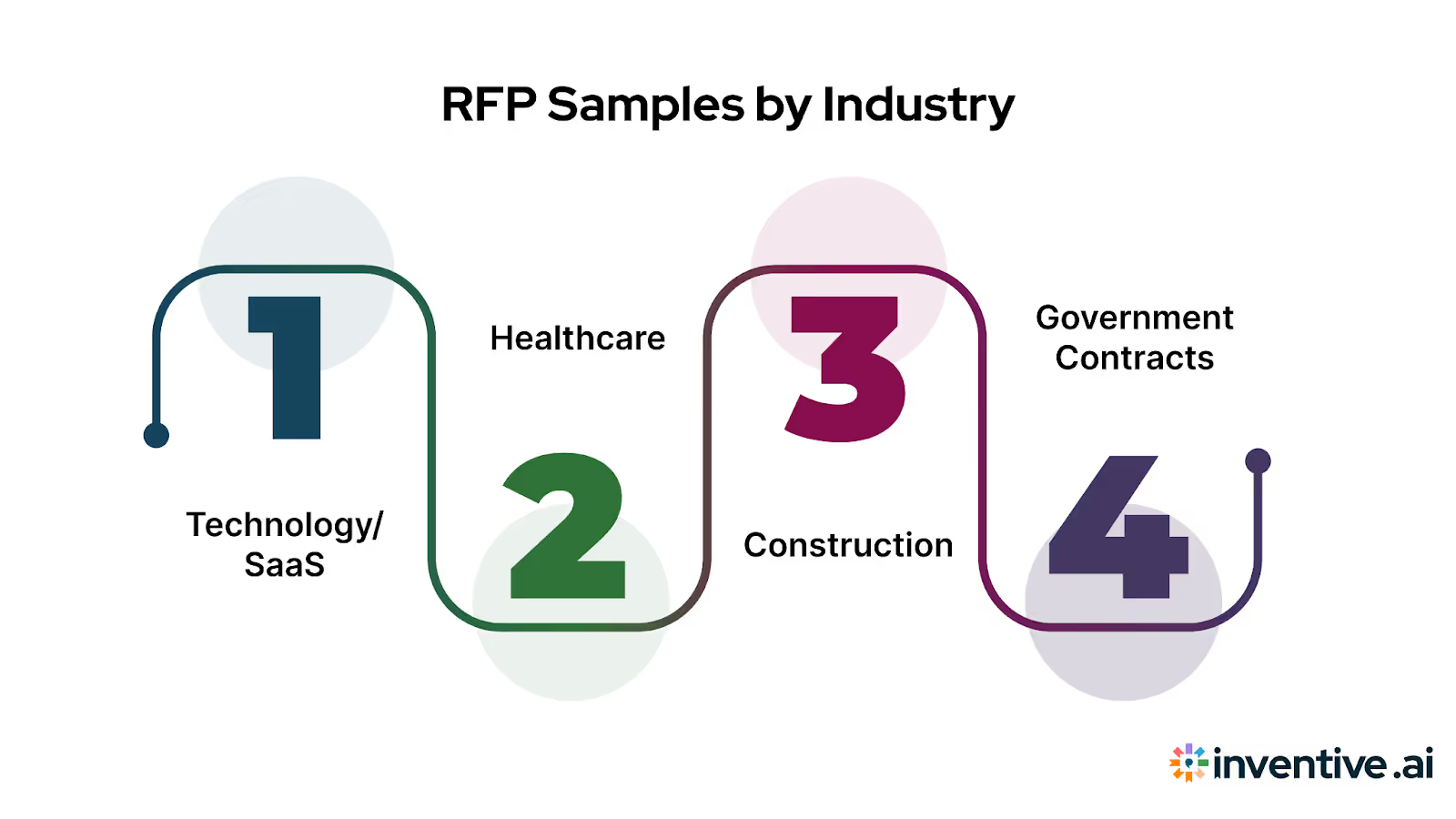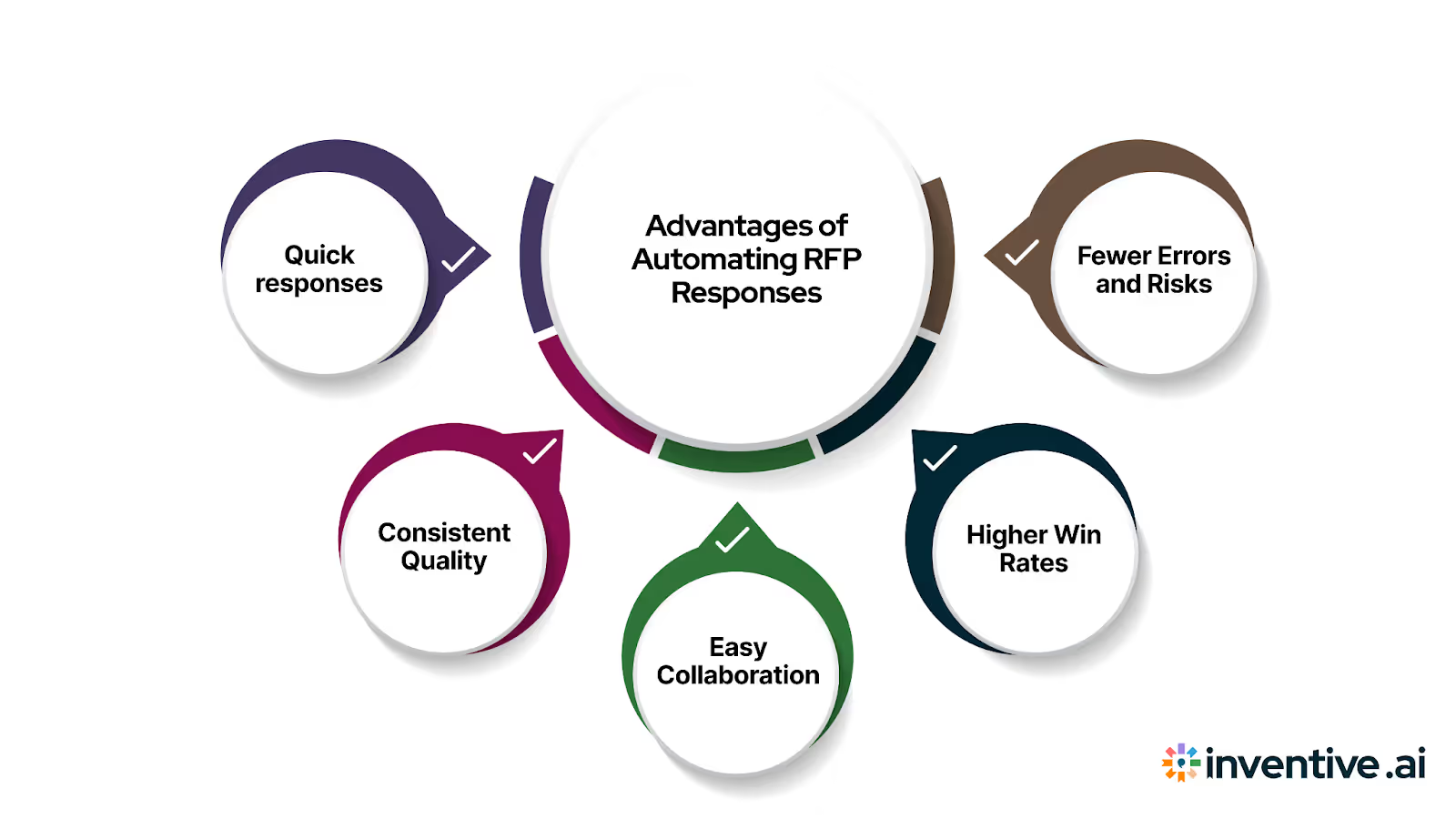Top RFP Response Examples and Template for 2025
If you’re part of a modern proposal team, you’re probably managing dozens — sometimes hundreds — of RFP responses each year.

Glossary of Key Terms
Introduction
If you’re part of a modern proposal team, you’re probably managing dozens — sometimes hundreds — of RFP responses each year. That means juggling multiple deadlines, high-stakes deals, and competing priorities.
RFPs are often the first and most critical step in winning major B2B partnerships. Whether it’s a government contract or a SaaS pitch, your response shapes how buyers judge your credibility, capability, and fit.
But when you’re stretched thin, responses can feel rushed, inconsistent, or too generic to stand out. It costs you deals, drains your team, and clutters your process.
A well-structured RFP response template changes that. It helps you move faster, stay consistent, and deliver proposals that land. No reinventing the wheel — just tailored, high-quality responses that show you understand the buyer.
In this blog, we’ll share RFP examples, smart structuring tips, and proven practices to help you respond faster, with confidence and purpose. Let’s dive in.
What Is a Request for Proposal (RFP)?
A Request for Proposal (RFP) is a formal document buyers use to ask vendors for project proposals. It outlines specific needs and expectations. You're expected to respond with a detailed plan to meet those requirements.
RFPs play a key role in the procurement process. They help buyers compare vendors fairly based on value, fit, and ability to deliver. Drafting a proper response can set you apart if you're in sales or business development. This is where a solid request for proposal example helps, as it gives structure and focus to your reply.
Where RFPs Are Commonly Used
RFPs aren't limited to one industry. They show up wherever organizations make high-value purchases or sign long-term service contracts. Common examples include:
- IT services: Companies often issue RFPs for managed IT support, cloud infrastructure, or cybersecurity assessments.
- Software vendors: Clients request proposals for CRM systems, custom apps, or platforms with integration and data compliance features.
- Healthcare: Hospitals seek vendors for EHR software, patient data storage, or HIPAA-compliant communication tools.
- Government contracts: Agencies post RFPs for everything from construction projects to digital services, all with strict compliance terms.
Each sector has its expectations, formats, and requirements. A request for proposal example tailored to your industry saves time and helps you avoid costly mistakes.
Why RFP Responses Are More Complex Today
If you've worked in enterprise sales, you've likely seen how RFPs have changed. They're no longer just checklists. Enterprises now want deeper answers, precise security details, and complete implementation plans. Many enterprise decision-makers say RFPs now require more technical and security-related documentation than three years ago, reflecting increased scrutiny in procurement processes.
That means you need to deliver responses that go beyond boilerplate content. You must show value, match technical specs, and prove reliability. With tighter deadlines and more stakeholders involved, the pressure to submit fast, accurate responses is real.
This is where AI-powered solutions like Inventive AI make a difference. They help structure, refine, and personalize every part of your RFP response, without starting from scratch each time.
Let's see what goes into a strong RFP response so you can see how each section fits together.
The Core Components of a Winning RFP Response

Writing a clear, structured response to an RFP can make or break your chances of winning the deal. Buyers expect thoughtful answers that align with their goals. Using a request for proposal example as your guide helps maintain structure and flow. Here are the essential components every strong RFP response should include.
- Executive Summary
Start with a short, focused summary. Outline what you offer, why it matters, and how it meets the buyer's goals. Keep it specific. Show that you understand the problem and have the right solution. A good executive summary should give decision-makers a reason to read the full proposal.
- Company Overview
This section builds trust. Give a brief background of your company, mission, and core services. Include key facts, such as team size, years in business, and notable partnerships. Don't make it too promotional. Think of it as context that supports the rest of your response.
- Detailed Response to Requirements
This is where you respond to each line item in the RFP. Be direct. Use the same structure and language the buyer used. Show that you've read their requirements carefully. Evaluators spend approximately 2.5 hours reviewing each RFP proposal, with teams typically allocating two weeks post-submission for evaluation. Inventive AI's RFP response software helps you build this section quickly using AI-generated content tailored to past requests. That means faster replies with fewer gaps or errors.
- Pricing Proposal
Keep your pricing transparent and well-organized. Break it down by service, feature, or phase if needed. Avoid surprises; buyers appreciate clear cost structures. With Inventive AI's centralized content tools, you can reuse approved pricing formats and stay consistent across responses.
- Implementation Plan
Lay out your delivery process. Include timelines, milestones, support steps, and team roles. This helps buyers understand what working with you will look like in practice. A strong request for proposal example will always include a detailed plan, especially in industries like software or IT services.
- Case Studies or Testimonials
Add social proof. Show past success with similar clients. Focus on outcomes, not just activities. For example, "Reduced onboarding time by 30% within 60 days" speaks more than a general claim. Inventive AI allows you to store and insert relevant case studies based on industry or project type.
- Legal and Compliance Documentation
This part often gets overlooked, but it matters. Include your security protocols, certifications, and standard contracts. Compliance is non-negotiable if you're responding to a healthcare or government RFP. Inventive AI helps keep this documentation up-to-date and easily reusable.
Each part of your response should reflect clarity, consistency, and intent. You're not just filling out a document. You're building confidence in your solution.
Next, let's look at real-world request for proposal examples from different industries and how you can use them to tailor your responses faster.
Request for Proposal Examples for Different Industries

Every industry has its own unique needs, expectations, and compliance rules. Using a tailored request for proposal example, you can ensure that your proposal is aligned with what buyers want. This approach not only saves time but also increases the relevance and effectiveness of your proposal. Here are some industry-specific RFP outlines you can quickly customize using Inventive AI's automation tools.
Technology/SaaS
In tech RFPs, buyers want to know your platform is secure, scalable, and easy to integrate. Support expectations are also high.
Tech/SaaS RFP Response Example
Healthcare
Healthcare RFPs place a heavy emphasis on compliance and patient data protection. Therefore, your responses should reflect a deep understanding and attention to these regulations. This is crucial for ensuring the safety and security of patient data.
Healthcare RFP Response Example
With Inventive's AI tools, you can pre-fill HIPAA language, map security protocols, and insert verified case studies from previous healthcare clients, all while keeping your brand voice consistent. This saves time and relieves you from the burden of repetitive tasks, allowing you to focus on the core aspects of your proposal.
Construction
Construction RFPs are primarily concerned with execution, timing, and past performance. Buyers are keen to see that you can meet deadlines and stay within budget. Therefore, your proposal should focus on these aspects to demonstrate your capability and reliability.
Construction RFP Response Example
Government Contracts
Government buyers focus on accountability, regulations, and demonstrated success. A request for proposal examples in this space must be transparent and compliant.
Government Contracts RFP Response Example
Request for proposal examples like these save time and reduce guesswork. They also keep your responses structured and relevant to your buyer's goals. By following these examples, you can feel confident that your proposal is on the right track.
Want to speed up your proposal process? Grab this RFP response template and customize it to craft polished proposals effortlessly. (No need for advanced design skills, this template is simple and ready to use!)
Next, let's walk through best practices to help you write proposals that win every time.
Best Practices for Writing Winning Proposals
Writing a proposal that gets noticed means more than answering questions. You need to sound relevant, professional, and easy to work with. Whether you're replying to a construction bid or a SaaS vendor request, these tips will help you improve every request for proposal example you send.
1. Personalize Every Response
Buyers can tell when you've copied content from another project. Generic responses lower your chances of winning.
- Speak directly to the buyer's goals, team, and industry
- Reference their project by name or scope
- Include relevant experience and results from similar work
For example, don't just say you understand HIPAA if you're responding to a healthcare RFP. Point to projects where you've handled PHI securely.
With Inventive AI, you can reuse core content while personalizing each section. The platform stores and suggests past answers but lets you edit them before submission.
2. Use Clear and Persuasive Language
Technical knowledge matters, but so does how you explain it. Make sure every word adds value and your responses convey confidence and competence.
- Skip jargon and over-explaining
- Stick to one point per paragraph
- Use action verbs and an active tone
Your request for proposal example should show confidence. Avoid long, padded descriptions. Clear language builds trust.
3. Demonstrate ROI and Client Outcomes
Buyers don't just want services, they want results. Reassure your buyers and show them what they'll get if they choose you.
- Share before-and-after outcomes
- Include stats that support your impact
- Add specific KPIs, savings, or growth figures
Example: "Reduced onboarding time by 40% for a SaaS client with a 3,000-user base." You can store these metrics in Inventive AI's content hub and attach them to future responses without rewriting.
4. Keep Formatting Professional and Accessible
Good formatting makes your content easier to read. It also keeps you compliant with technical RFP submission rules.
- Use clean headings and white space.
- Stick to one font and size.
- Format all attachments clearly and consistently.
Many buyers use scoring systems. If your formatting is inconsistent or dense, it could cost you points.
Inventive AI helps you create personalized, high-quality RFP responses faster. It suggests content from your past proposals, applies consistent formatting, and supports team collaboration. You save time, reduce errors, and respond with confidence every time. See how it works →
Benefits of Automating RFP Responses
Manual RFP responses take time, drain resources, and often lead to errors. Automating this process brings clear, measurable value, especially at scale. More than half (54%) of organizations are either trialing or have fully deployed AI within Strategic Response Management (SRM) workflows, such as RFPs, security questionnaires, and due diligence questionnaires.

Here's what you gain:
- Quick responses: With automation, you can respond to more RFPs in less time, thanks to AI-assisted drafts and reusable content. This empowerment gives you the confidence to handle a higher volume of RFPs with a faster turnaround.
- Consistent Quality: Pull from pre-approved answers and brand-aligned templates. No more guessing or rewriting from scratch.
- Easy Collaboration: Assign sections, track progress, and manage approvals in one place. This efficient collaboration keeps teams aligned and productive, without the need to chase updates.
- Higher Win Rates: Stronger responses are delivered faster, giving you a competitive edge. Personalization and accuracy help you stand out.
- Fewer Errors and Risks: Avoid compliance gaps and versioning issues. With automation, your content stays clean, accurate, and on message.
Inventive AI combines all these benefits, enabling you to create smarter RFP workflows that win business.
Let's explore how Inventive AI makes this process even more efficient, from draft to approval.
How Inventive AI Optimizes the RFP Response Process
Responding to RFPs shouldn't slow your team down. Inventive AI makes the process faster, more accurate, and easier to manage at scale. Whether you're working on a simple request for proposal example or a complex enterprise bid, the platform keeps things sharp and consistent.
Here's how Inventive AI works for you:
- AI-Generated Content
Get fast, tailored drafts based on your past responses and project needs. Customers report 3x faster RFP turnaround times using Inventive's AI-generated answers.
- Centralized Content Repository
Store, manage, and reuse high-performing responses in one searchable library. Teams save up to 70% of response-writing time by not starting from scratch.
- Team Collaboration Tools
Built-in task tracking, comments, and status updates streamline teamwork. Cross-functional teams stay aligned without version-control chaos.
- Custom Workflows & Approvals
Define your own review and sign-off steps. Maintain brand voice, accuracy, and compliance at every stage with no bottlenecks.
Why it matters for businesses like yours:
- 50% increase in proposal win rates by delivering tailored, consistent responses
- 4x faster content reuse from a centralized knowledge base
- Better compliance, fewer errors, and a more scalable process, especially for large teams responding to dozens of RFPs monthly.
When your team is working on a tight deadline and needs to submit a polished request for proposal example, Inventive AI gives you the tools to do it right and fast.
Here's what our clients say:
"Saved our Presales team a ton of time. Response quality is high, and the chatbot is useful for ad hoc responses."
– Verified G2 reviewer, Solutions Engineering team
"It helps me save time by automating tasks in RFP creation and content management… speeds up document preparation and makes it easier to find information."
– Verified G2 reviewer, logistics & supply chain
See what Inventive AI can do for you
Schedule your FREE 30‑minute demo to discover how you can:
- Create intelligent drafts instantly with AI assistance
- Maintain a centralized, searchable RFP knowledge base
- Scale your team's output without extra hires
- Win more deals with consistent, high-quality proposals
Take a step and accelerate your RFP success!
Conclusion
Winning more RFPs isn't about chasing every opportunity. It's about responding to the right ones with clarity, speed, and precision. Every piece matters, from writing a clear executive summary to tailoring answers using a relevant request for proposal example. The process demands focus, coordination, and consistency, especially at enterprise scale.
That's where AI tools like Inventive bring real value. You get faster turnarounds, a single source of truth for your content, and a better chance at standing out with persuasive, high-quality responses.
Close more deals with less effort. See how Inventive AI streamlines every step of your RFP process. Book a demo today →


